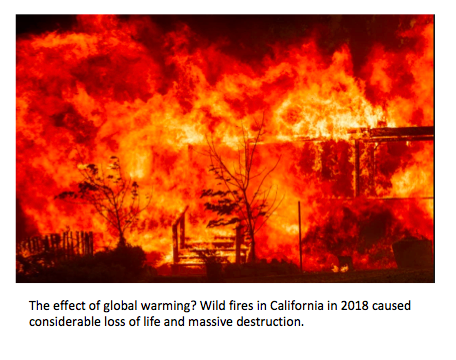C.5 Environmental impact - global warming
Written specifically for students to provide help and support for the IB Diploma chemistry programme this page provides full coverage of the syllabus content of Option C - sub topic C.5. It encourages you to think critically and provides many questions with full worked answers so that you can monitor and improve your knowledge and understanding.


 Learning outcomes
Learning outcomes
After studying this topic you should be able to:
 Understand:
Understand:
- Greenhouse gases allow incoming solar short wavelength radiation to pass through but absorb the longer wavelength radiation from the Earth. Some of this absorbed radiation is re-radiated back to Earth.
- The concentration of atmospheric carbon dioxide in the atmosphere and aqueous carbon dioxide in the oceans exist in heterogeneous equilibrium.
- Greenhouse gases absorb infrared radiation because there is a change in dipole moment when the bonds in the molecule stretch and bend.
- Clouds and particulates, e.g. smoke and dust, cause global dimming as they reflect sunlight.
Apply your knowledge to:
- Explain the molecular mechanisms by which greenhouse gases absorb infrared radiation.
- Discuss the evidence for the relationship between the increased concentration of greenhouse gases and global warming.
- Discuss the sources, relative abundance and effects of different greenhouse gases.
- Discuss the different approaches for controlling carbon dioxide emissions.
- Discuss pH changes in the ocean due to increased concentration of carbon dioxide in the atmosphere.
Relationships & vocabulary
Nature of science
The study of global warming is transdisciplinary and involves a wide range of concepts and ideas.
The work of the Intergovernmental Panel on Climate Change (IPCC) involves collaboration and the explanation of science to the public.
There is a clear correlation between carbon dioxide levels and the average temperature of the Earth, although wide variations in the Earth's surface temperature have occurred frequently in the past.
International-mindedness
Global warming involves The international community is working together to research and reduce the effects of global warming. Such attempts include the Intergovernmental Panel on Climate Change (IPCC) and the 1997 Kyoto Protocol which came into force in 2005 and was later was amended and extended in Doha, Qatar in 2012 and in Paris in 2016. Agreement on how it can be implemented was reached at Katowice in 2018.
Vocabulary
| greenhouse gas | dipole moment | carbon capture | sequestration | troposphere |
Learning slides
You can use this slide gallery for learning or for reviewing concepts and information. It covers all the key points in the syllabus for this sub-topic.
Something to think about
In August 2015 President Obama announced a Clean Power Plan for the US. This introduces, for the first time, national standards to limit carbon pollution from power plants. By the year 2030 the plan aims to reduce carbon dioxide emissions from their 2005 levels by 32 percent. Energy efficiency, energy conservation and switching to sustainable non-carbon energy sources all form part of the plan. Realistically, however, fossils fuels are still an important energy source so much of the emphasis will be on reducing the carbon dioxide emissions from the power stations to the atmosphere. This will be done by improved carbon capture and sequestration.
Carbon capture (really carbon dioxide capture) can be done pre-combustion, post-combustion or by oxyfuel combustion. In the pre-combustion process the fossil fuel is partially oxidised to form syngas, a mixture of carbon monoxide and hydrogen. This is converted into carbon dioxide and hydrogen and the carbon dioxide removed before the hydrogen is burned as a fuel. The oxyfuel combustion involves burning the fossil fuel in oxygen rather than air so that complete combustion occurs to give nearly pure carbon dioxide and water from which the water can be removed by cooling. The captured carbon is then transported (usually through pipes in the form of compressed carbon dioxide) to sites where it can be geologically sequestrated by injecting it into porous rocks more than a mile underground. The carbon dioxide is trapped in these porous rocks as the layers above comprise of impermeable non-porous rocks.

Sequestration (Image from United States Environmental Protection Agency)
![]() Carbon sequestration - The National Energy Technology lab
Carbon sequestration - The National Energy Technology lab
Test your understanding of this topic
(Note that your teacher may have restricted your access to some or all of these questions and worked answers if they are going to use them as a class test or set them as an assignment.)
For ten 'quiz' questions (for quick testing of knowledge and understanding with the answers explained) see MC test: Environmental impact – global warming.
For short-answer questions see Environmental impact - global warming questions together with the worked answers on a separate page Environmental impact - global warming answers.
More resources
1. A good three minute animated video explaining how greenhouses gases work which covers most of the main facts (although only talks about 'lopsided' rather than 'change in dipole moment') from MinuteEarth.
![]() How do greenhouse gases actually work?
How do greenhouse gases actually work?
2 - 8. A series of seven short videos by the National Research Council presenting the evidence that greenhouse gases do affect climate .

 IB Docs (2) Team
IB Docs (2) Team 


















